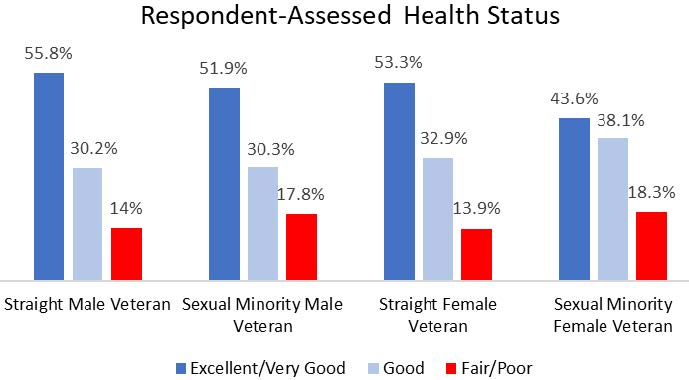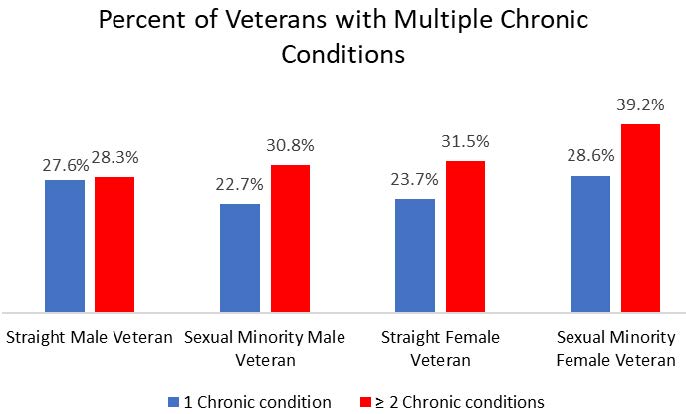Health Disparities Among LGBT Veterans
|
 |
OHE would like to extend a special thanks to our partners at the National Center for Health Statistics (NCHS)
Download PDF
INTRODUCTION
The Veterans Health Administration (VHA) serves a Veteran population that is increasingly diverse. Equitable access to high-quality care for all Veterans is a major tenet of the VA healthcare mission. The Office of Health Equity (OHE) champions the elimination of health disparities and achieving health equity for all Veterans, including LGBT Veterans.
V The language of the Lesbian, Gay, Bisexual, and Transgender (LGBT) community is expansive and continuously changing. The use of the acronym “LGBT” in this brief is intended to be inclusive of all sexual and gender minority individuals.
HEALTH DISPARITIES
LGBT Veterans are at a disproportionate risk for suicide and other poor health outcomes (Mereish, et al., 2012), due in part to barriers in accessing services and lack of social support (Bryant & Schilt, 2008; Moradi, 2009). Sexual and gender minority Veterans have faced stigma and discrimination, which can affect their health. LGBT Veterans are more likely to report that their health is fair or poor and that they have multiple chronic conditions.
To find data on LGBT and other groups of Veterans, visit: https://www.cdc.gov/nchs/nhis/veterans_health_statistics/veterans-health-info.htm

*Data includes all VHA users, adjusted for age and sex
REDUCING DISPARITIES AND IMPROVING ACCESS
Barriers to receiving culturally competent healthcare can contribute to worse health outcomes for LGBT individuals. A provider’s knowledge of a patient’s LGBT status is essential to providing appropriate prevention screening and care.
Provider-focused education and inclusive facility policies are beginning to raise awareness about the unique needs and healthcare disparities facing LGBT Veterans. There is growing support that these methods have contributed to improved LGBT Veteran experience with VHA services (Kauth, et al., 2018). Beyond inclusive healthcare policies and provider training, patient health education is a method for encouraging positive health behavior choices.
PRIDE IN ALL WHO SERVED
The “PRIDE In All Who Served” project strives to address healthcare disparities by directly providing information about unique healthcare needs to the Veteran population. Providing education in a supportive peer environment empowers LGBT Veterans to navigate the VHA system and thus, reduce healthcare disparities. One area of emphasis is focused on minimizing the risk factors for suicide, which disproportionately affects LGBT Veterans when compared to the general Veteran population.
The “PRIDE In All Who Served” 10-week health education group was developed for LGBT Veterans with a focus on reducing healthcare disparities. Group facilitators follow a session-by-session manual with corresponding Veteran handouts on each topic including information about how to access relevant services within the VHA system. Session content focuses on overall wellness, increasing social connectedness, and empowering Veterans to engage in services related to their personal healthcare needs.
Developed at the Hampton VA, the program has been successfully replicated and evaluated at facilities across the country through a partnership with the Tuscaloosa VA. Support from the VHA Innovators Network enabled quick dissemination to more than 15 facilities in two years.
To learn more about the “PRIDE In All Who Served” project, visit: https://marketplace.va.gov/practices/pride-in-all-who-served-reducing-healthcare-disparities-for-lgbt-veterans
For more information about the Office of Health Equity visit: https://www.va.gov/healthequity/
For additional OHE information briefs and fact sheets visit: https://www.va.gov/HEALTHEQUITY/Publications_and_Research.asp
REFERENCES
Bryant, K. & Schilt, K. (2008). Transgender people in the U.S. military: Summary and analysis of the 2008 transgender American veterans associations survey. White Paper. Retrieved from: http://archive.palmcenter.org/files/TGPeopleUSMilitary.pdf
Kauth, M. R., et al. (2018). Lesbian, gay, and transgender veterans’ experiences in the veterans health administration: Positive signs and room for improvement. Psychological Services. Advance online publication. http://dx.doi.org/10.1037/ser0000232
Mereish, E.H., et al. (2012). Interrelationships between LGBT-based victimization, suicide, and substance use problems in a diverse sample of sexual and gender minorities. Psychology, Health & Medicine, 19, 1-13. http://dx.doi.org/10.1080/13548506.2013.780129
Moradi, B. (2009). Sexual orientation disclosure, concealment, harassment, and military cohesion: Perceptions of LGBT military veterans. Military Psychology, 21 (4): 513-533.
Zelaya CE, Boersma P, Moy E. Crude and age-adjusted percent distribution of respondent-assessed health status among adults aged 20 and over, by veteran status and other selected characteristics: United States, 2015-2018. National Center for Health Statistics 2020.
Zelaya CE, Boersma P, Moy E. Crude and age-adjusted percent distribution of number of chronic conditions among adults aged 20 and over, by veteran status and other selected characteristics: United States, 2015-2018. National Center for Health Statistics 2020.























